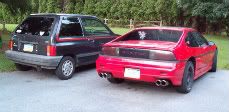1990 ford Festiva, FWD manual rack/pinion.
The car has started making a whirring/grinding type of noise from the right front. Turning the car right eliminates the noise. While driving the car gets a mild vibration thru the wheel and some vibration when braking. Vibration is speed dependent. Handling has gotten skittish (will vaguely move itself around with no steering wheel input). Car does make a clicking sound when turned left to the lock.
The wheel bearings are always suspect on these cars, so I lifted the car and got no play pushing @ 12oclock/6oclock. However, I get some slop from 3oclock/9oclock. I looked and it appears as if the inner tie rod is moving in the rack, which I see as the steering rack having too much play. Can the rack be faulty and cause the symptoms I have?
The car has started making a whirring/grinding type of noise from the right front. Turning the car right eliminates the noise. While driving the car gets a mild vibration thru the wheel and some vibration when braking. Vibration is speed dependent. Handling has gotten skittish (will vaguely move itself around with no steering wheel input). Car does make a clicking sound when turned left to the lock.
The wheel bearings are always suspect on these cars, so I lifted the car and got no play pushing @ 12oclock/6oclock. However, I get some slop from 3oclock/9oclock. I looked and it appears as if the inner tie rod is moving in the rack, which I see as the steering rack having too much play. Can the rack be faulty and cause the symptoms I have?

Comment